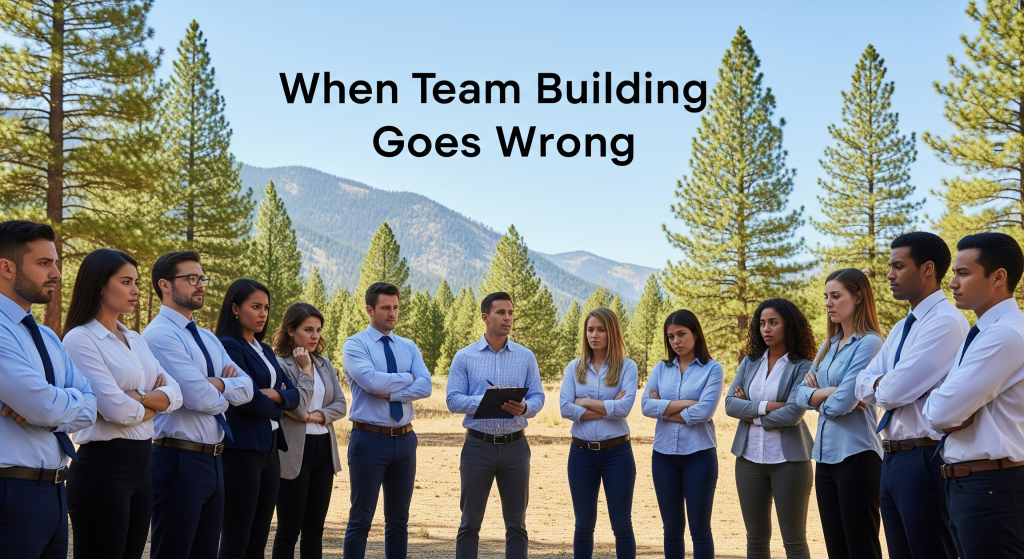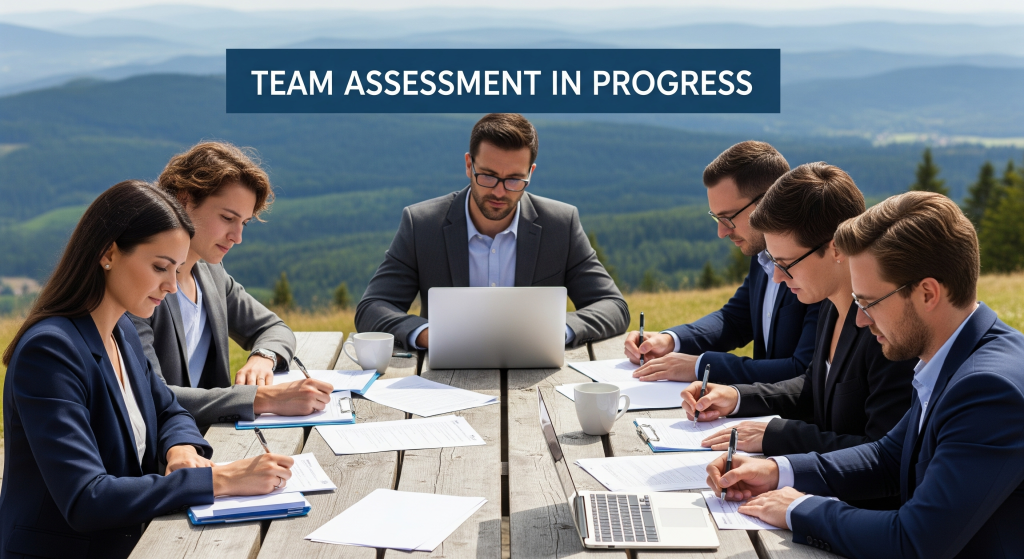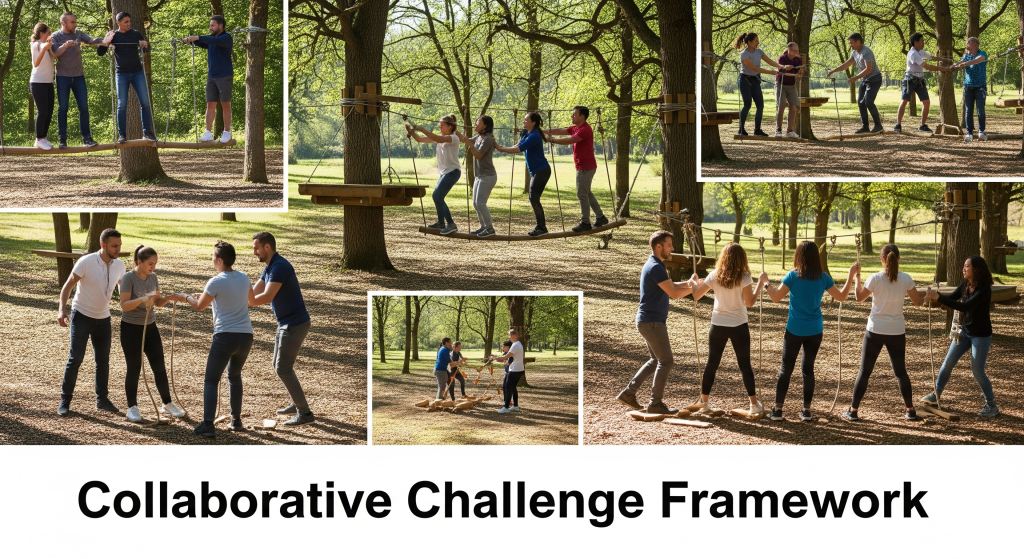Company retreat planning can make or break your team’s morale for the entire year. After organizing over 200 corporate retreats in my five years as a team development consultant, I’ve seen companies spend thousands on events that left employees more frustrated than motivated. But I’ve also witnessed retreats that transformed struggling teams into high-performing units.
The difference isn’t the budget or the location. It’s understanding what actually drives team bonding and applying proven strategies that create lasting connections. Most retreat planners focus on fun activities without considering the deeper psychology of team building. This approach fails because it treats symptoms rather than addressing the root causes of workplace disconnection.
My name is Richard Boren, and I’ve been specializing in corporate team development since 2020. I started this journey after witnessing my own company’s disastrous retreat in Miami, where employees spent more time complaining about forced trust falls than actually connecting. That experience drove me to study organizational psychology and develop retreat frameworks that actually work. Over the past five years, I’ve helped Fortune 500 companies and small startups create meaningful team experiences that improve collaboration, communication, and workplace satisfaction long after everyone returns to the office.
Why Most Company Retreats Fail Miserably

Most retreat planning starts with the wrong question. Companies ask “what activities should we do?” instead of “what outcomes do we need?” This backwards approach leads to generic team-building exercises that feel forced and artificial.
The biggest mistake I see is treating all teams the same. A software development team needs different bonding experiences than a sales team. Remote workers have different challenges than office-based employees. New teams require different approaches than established groups facing specific conflicts.
Here’s what typically goes wrong:
Generic Activity Selection: Companies pick popular activities without considering their team’s personality types, comfort levels, or actual workplace challenges. I once watched a group of introverted accountants suffer through an outdoor obstacle course that left them exhausted and resentful.
Poor Timing and Pacing: Cramming too many activities into limited time creates stress instead of relaxation. Teams need downtime to process experiences and form organic connections.
Ignoring Workplace Dynamics: Successful retreats address real workplace issues. If your team struggles with communication, rock climbing won’t solve that problem unless it’s specifically designed to improve communication skills.
Lack of Follow-Through: The retreat ends, everyone goes back to work, and nothing changes. Without proper integration strategies, even great retreat experiences fade within weeks.
| Common Retreat Mistakes | Impact on Team | Better Alternative |
|---|---|---|
| Generic trust exercises | Feels forced, creates resistance | Customized challenges based on team dynamics |
| Overpacked schedules | Stress and exhaustion | Balanced activity and reflection time |
| No workplace integration | Temporary effect only | Structured follow-up and implementation |
| One-size-fits-all approach | Disengaged participants | Personalized team assessment first |
The Science Behind Effective Team Bonding
Effective team bonding happens when people feel psychologically safe, experience shared challenges, and develop mutual understanding. Research from Harvard Business School shows that psychological safety is the strongest predictor of team performance.
Creating psychological safety requires three elements: trust, vulnerability, and shared purpose. Traditional team-building activities often skip these foundations and jump straight to surface-level fun. This explains why rope courses and scavenger hunts rarely produce lasting results.
Vulnerability-Based Trust Building: Patrick Lencioni’s research demonstrates that teams bond when members share appropriate vulnerabilities. This doesn’t mean oversharing personal problems. It means acknowledging professional challenges, admitting mistakes, and asking for help when needed.
Shared Challenge Principle: Teams that overcome difficulties together develop stronger bonds than those who simply have fun together. The key is choosing challenges that require collaboration and communication to solve.
Identity Integration: People connect when they see beyond work roles and understand each other as complete individuals. Effective retreats create opportunities for this deeper understanding without forcing uncomfortable personal disclosure.
In my experience with tech startup Velocity Labs, their team was struggling with cross-departmental communication. Instead of generic team exercises, we designed challenges that required developers, marketers, and sales staff to solve problems together using each person’s unique expertise. Six months later, their project completion rate improved by 40%.
Essential Pre-Retreat Assessment Strategies

Smart retreat planning starts with understanding your team’s current state. I use a three-part assessment process that reveals the specific bonding challenges your team faces.
Team Dynamics Audit
Survey your team about current collaboration challenges. Ask specific questions about communication patterns, conflict resolution, and trust levels. Don’t rely on manager observations alone. Frontline employees often see different dynamics than leadership.
The assessment should cover:
- Communication effectiveness between departments
- Comfort level with giving and receiving feedback
- Perceived fairness in decision-making processes
- Understanding of individual roles and responsibilities
- Trust levels between team members and leadership
Individual Personality Mapping
Understanding personality types helps design activities that engage everyone. I use a simplified version of DISC assessment focusing on communication styles and comfort zones. This prevents planning activities that exclude or overwhelm certain personality types.
Dominant personalities thrive on competitive challenges and leadership opportunities. Influential types enjoy social interaction and creative problem-solving. Steady personalities prefer collaborative activities with clear structure. Conscientious individuals appreciate detailed planning and purposeful activities.
Workplace Challenge Identification
Every team has specific collaboration pain points. Remote teams might struggle with informal communication. Cross-functional teams often have unclear responsibilities. New teams lack established trust patterns.
Document these challenges clearly. Your retreat activities should directly address these issues through structured experiences that mirror workplace situations but in a more relaxed environment.
Location Selection That Actually Matters
Location affects team bonding more than most planners realize. The environment influences behavior, energy levels, and openness to new experiences. I’ve seen identical team-building programs produce completely different results based solely on venue choice.
Off-Site vs On-Site Considerations
Off-site locations remove workplace distractions and hierarchies. People behave differently outside their normal environment. However, off-site retreats require more planning and higher budgets.
On-site retreats work well for teams with limited budgets or time constraints. They’re easier to manage but require careful attention to creating separation from normal work routines.
Off-Site Advantages:
- Complete break from work environment
- Neutral territory reduces hierarchical thinking
- Overnight stays extend bonding time
- More dramatic, memorable experiences
On-Site Benefits:
- Lower cost and logistics complexity
- Easier attendance for parents and caregivers
- Familiar, comfortable environment
- Easy access to work materials if needed
Environment Psychology Factors
Natural settings reduce stress and promote creativity. Urban environments can energize teams but may create distractions. Indoor venues offer climate control and predictability but might feel corporate.
I prefer locations with both indoor and outdoor options. This flexibility allows activities to continue regardless of weather and accommodates different comfort levels. Mountain lodges, lake resorts, and conference centers with extensive grounds work well.
Key Location Criteria:
- Multiple meeting spaces for different group sizes
- Outdoor areas for physical activities
- Quiet spaces for reflection and small group discussions
- Good acoustics for group conversations
- Minimal outside distractions
Activity Design Framework for Deep Connection

The most effective retreat activities share three characteristics: they require genuine collaboration, involve appropriate challenge levels, and create opportunities for authentic interaction.
The Three-Layer Activity Model
Layer 1: Comfort Zone Expansion Start with activities that gently push boundaries without creating anxiety. These warm-up experiences help people adjust to the retreat environment and begin interacting differently than they do at work.
Example: Problem-solving challenges that require different expertise from various team members. Each person contributes their unique skills while learning about others’ capabilities.
Layer 2: Collaborative Challenge Design activities that cannot be completed individually. The challenge level should require effort but remain achievable with good teamwork. Success should depend on communication and coordination, not individual talent.
Layer 3: Reflection and Integration Every activity sequence ends with structured reflection. Teams discuss what they learned about working together and how insights apply to workplace situations.
Real-World Activity Examples That Work
Communication Challenge Course: Teams navigate physical obstacles while maintaining constant verbal communication. One person guides blindfolded teammates through a course using only verbal directions. This directly mirrors workplace communication challenges.
Cross-Functional Innovation Labs: Mixed groups from different departments work together to solve real company challenges. Marketing, IT, and operations collaborate on projects outside their normal scope. This builds understanding of different perspectives and working styles.
Storytelling Circles: Structured sharing sessions where team members tell stories about professional challenges they’ve overcome. This builds empathy and reveals problem-solving approaches without forced vulnerability.
| Activity Type | Team Size | Duration | Skill Focus | Difficulty Level |
|---|---|---|---|---|
| Communication Course | 6-8 people | 90 minutes | Active listening, clear instruction | Moderate |
| Innovation Labs | 4-6 people | 3 hours | Creative thinking, collaboration | Challenging |
| Storytelling Circles | 8-12 people | 60 minutes | Empathy, perspective-taking | Easy |
| Problem-Solving Escape Rooms | 5-7 people | 2 hours | Logical thinking, teamwork | Moderate-Hard |
The Psychology of Shared Experiences
Shared experiences create what psychologists call “collective effervescence”—a feeling of energy and harmony that emerges when people participate in group activities. This phenomenon explains why teams that struggle together often develop stronger bonds than those who simply socialize.
Creating Memorable Moments
Memorable experiences happen when people feel challenged, supported, and successful simultaneously. The brain releases bonding chemicals during these peak moments, creating stronger interpersonal connections.
Design activities with clear beginnings, middles, and ends. Teams need to experience the full cycle of challenge, struggle, breakthrough, and celebration together. This complete emotional journey creates lasting memories and associations.
Peak-End Rule Application: People remember experiences based on their peak moment and how they ended. Ensure activities have clear high points and positive conclusions. Even if teams struggle during an activity, a successful resolution creates positive memories.
Emotional Contagion in Groups
Emotions spread rapidly through groups. One person’s enthusiasm or anxiety affects everyone. Skilled retreat facilitators monitor group energy and adjust activities accordingly.
Start each session by setting positive emotional tone. Use energizing warm-ups and ensure early success experiences. When teams feel confident and positive, they’re more open to challenging activities and deeper connections.
Budget Optimization Without Sacrificing Quality
Effective retreats don’t require huge budgets. I’ve organized powerful team bonding experiences for under $100 per person and seen expensive retreats fail completely. The key is strategic resource allocation.
High-Impact, Low-Cost Strategies
Local Venue Partnerships: Many venues offer package deals that include meeting spaces, catering, and activity options. Negotiate multi-day packages for better rates.
Internal Expertise Utilization: Your team probably includes people with facilitation skills, creative abilities, or unique knowledge. Incorporate these internal resources into retreat programming.
Equipment Sharing and Borrowing: Instead of renting expensive equipment, partner with local organizations or borrow from other companies. Many businesses are willing to share resources in exchange for future reciprocity.
Seasonal Timing: Off-season venues offer significant discounts. Spring and fall often provide ideal weather without peak pricing.
Cost-Benefit Analysis Framework
| Budget Category | Percentage of Total | Impact on Team Bonding | Cost-Saving Opportunities |
|---|---|---|---|
| Venue and Lodging | 40-50% | High – sets environment tone | Off-season booking, local partnerships |
| Food and Catering | 20-30% | Medium – supports energy and mood | Group cooking activities, local catering |
| Activities and Facilitation | 15-25% | Very High – core bonding experiences | Internal facilitators, equipment sharing |
| Transportation | 10-15% | Low – convenience factor | Carpooling, local venues |
| Materials and Supplies | 5-10% | Low – supporting role only | Bulk purchasing, reusable items |
ROI Measurement: Track measurable outcomes like employee satisfaction scores, retention rates, and collaboration metrics. Teams that experience effective retreats show 25-35% improvement in cross-departmental project success rates.
Technology Integration for Modern Teams
Modern retreat planning must consider how technology can enhance rather than distract from team bonding. Remote team members, digital collaboration tools, and social media integration all play important roles in contemporary retreat experiences.
Digital Collaboration Tools
Use technology to extend retreat experiences before and after the event. Pre-retreat surveys and goal-setting apps help teams arrive with clear intentions. Post-retreat communication platforms maintain connections and track progress on retreat commitments.
Virtual Participation Options: Include remote team members through video calls during key activities. Design hybrid activities where in-person and virtual participants collaborate on equal footing.
Documentation and Sharing: Encourage teams to document their experiences through photos, videos, and reflection journals. Create private social groups where team members can share retreat memories and continue conversations.
Digital Detox Balance
While technology integration matters, periods of digital disconnection often produce the deepest bonding experiences. Plan specific technology-free zones and times.
I recommend a graduated approach: start with partial disconnection during activities, then progress to longer offline periods. This respects different comfort levels while still creating space for authentic interaction.
Measuring Retreat Success and ROI

Successful retreats produce measurable improvements in team performance. I track both immediate feedback and long-term behavioral changes to assess retreat effectiveness.
Immediate Assessment Metrics
Participant Satisfaction Scores: Survey attendees immediately after the retreat and again two weeks later. Compare scores to identify which activities produced lasting positive impact.
Engagement Observation: During activities, note participation levels, energy changes, and spontaneous interactions. Teams that bond effectively show increased voluntary collaboration and positive body language.
Goal Achievement Tracking: Measure progress on specific retreat objectives. If the goal was improving communication, track meeting effectiveness and conflict resolution success rates.
Long-Term Impact Measurement
Collaboration Frequency: Monitor how often team members initiate cross-departmental projects or seek input from colleagues they connected with during the retreat.
Retention and Satisfaction: Teams with effective retreat experiences show 20-30% lower turnover rates and higher employee satisfaction scores six months post-retreat.
Performance Indicators: Track project completion rates, meeting efficiency, and innovation metrics. Strong team bonds directly correlate with improved work outcomes.
| Measurement Timeline | Metrics to Track | Success Indicators |
|---|---|---|
| Immediately Post-Retreat | Satisfaction scores, energy levels | 85%+ positive feedback |
| 2 Weeks Later | Behavior changes, goal progress | Sustained engagement |
| 3 Months Later | Collaboration frequency, project success | 25%+ improvement |
| 6 Months Later | Retention, satisfaction, performance | Measurable business impact |
Common Pitfalls and How to Avoid Them
Every retreat planner makes mistakes. Learning from common pitfalls saves time, money, and team relationships. Here are the most frequent problems I encounter and their solutions.
Over-Programming vs Under-Structure
The Problem: Either cramming too many activities into limited time or providing so little structure that teams feel directionless.
The Solution: Plan 70% of available time with specific activities. Reserve 30% for organic interaction, meals, and processing time. Teams need structure to feel secure but space to form natural connections.
Forced Fun Syndrome
The Problem: Activities that feel mandatory rather than engaging. When people resist participation, bonding opportunities disappear.
The Solution: Offer activity choices whenever possible. Provide alternative ways to participate for those uncomfortable with specific activities. Focus on inclusive experiences that work for different personality types and physical abilities.
Ignoring Workplace Hierarchies
The Problem: Assuming retreat environments automatically eliminate normal power dynamics.
The Solution: Deliberately design activities that shuffle normal hierarchies. Mix teams randomly for different activities. Create leadership rotation where different people guide various exercises.
Advanced Team Bonding Techniques
After mastering basic retreat planning, advanced techniques create deeper, more lasting connections. These strategies require more sophisticated facilitation but produce significantly better results.
Vulnerability-Based Trust Exercises
Real trust develops when people share appropriate professional vulnerabilities. Design activities where team members discuss work challenges, admit knowledge gaps, or ask for help with genuine workplace issues.
Professional Challenge Sharing: Teams discuss real projects where they needed help but felt unable to ask. This opens conversations about workplace support systems and collaboration barriers.
Skill Exchange Sessions: Everyone teaches something they know well to others. This creates mutual appreciation and reveals hidden talents within the team.
Conflict Resolution Integration
Address existing team tensions through structured conflict resolution activities. This requires skilled facilitation but produces dramatic improvements in team dynamics.
Perspective-Taking Exercises: Team members argue for positions they normally oppose. This builds empathy and understanding of different viewpoints.
Communication Style Workshops: Teams learn about different communication preferences and practice adapting their styles for better collaboration.
Logistics and Operational Excellence
Smooth operations allow teams to focus on bonding rather than logistical problems. Detailed planning prevents small issues from becoming major distractions.
Pre-Retreat Preparation
Team Communication: Send clear expectations, schedules, and packing lists two weeks before the retreat. Include information about activity levels, weather considerations, and any special requirements.
Dietary and Accessibility Planning: Survey attendees about dietary restrictions, mobility limitations, and comfort levels with different activities. Plan alternatives for those who cannot participate in specific exercises.
Emergency Protocols: Establish clear procedures for medical emergencies, severe weather, or other unexpected situations. Designate point persons and communication methods.
During-Retreat Management
Flexible Scheduling: Build buffer time between activities. Some exercises run long when teams are engaged, while others finish quickly if they’re not working well.
Energy Management: Monitor group energy levels throughout the day. Plan high-energy activities when teams are fresh and reflective activities when energy dips.
Real-Time Adaptation: Be prepared to modify activities based on how teams respond. Skilled facilitators read group dynamics and adjust programming accordingly.
Technology and Remote Team Considerations
Modern teams often include remote workers, multiple generations, and varied technology comfort levels. Effective retreat planning addresses these realities.
Hybrid Team Integration
Pre-Retreat Virtual Meetups: Organize online social sessions before in-person retreats so remote workers feel connected when they arrive.
Technology-Enhanced Activities: Use apps and digital tools to create collaborative experiences that feel natural to tech-savvy team members while remaining accessible to others.
Documentation and Sharing: Create digital spaces where teams can continue retreat conversations and share resources discovered during activities.
Generational Preferences
Multi-Modal Learning: Combine traditional discussion formats with digital collaboration tools, hands-on activities, and visual presentations to engage different learning styles.
Communication Channel Variety: Use various communication methods throughout the retreat. Some people prefer face-to-face discussion, others respond better to written reflection, and some need movement-based activities.
Frequently Asked Questions
How far in advance should we plan a company retreat? Start planning 3-4 months ahead for optimal venue selection and team preparation. Complex retreats with custom activities need 6 months lead time. Last-minute planning limits options and increases costs significantly.
What’s the ideal retreat duration for maximum team bonding? Two full days plus travel time provides the best balance of depth and practicality. One-day retreats feel rushed, while longer retreats can feel overwhelming and expensive. Overnight stays create more bonding opportunities than same-day events.
How do we handle employees who resist team-building activities? Offer multiple participation levels and alternative ways to contribute. Some people bond through observation rather than direct participation. Focus on inclusive activities that don’t require everyone to behave the same way.
What should we do if team conflicts surface during retreat activities? Address conflicts immediately with professional facilitation. Retreats often reveal existing tensions that need resolution. Have a qualified mediator available and clear protocols for handling difficult conversations.
Conclusion
Effective company retreat planning requires understanding your team’s specific needs, designing purposeful activities, and creating environments where authentic connections can develop. The most successful retreats I’ve organized focused on real workplace challenges while providing enough psychological safety for people to interact differently than they do in the office.
The key insight from my five years of retreat planning experience is this: teams bond when they solve problems together, not when they simply have fun together. Design your retreat around meaningful collaboration challenges, provide excellent logistical support, and measure results to ensure your investment produces lasting improvements.
Remember that retreat planning is an investment in your team’s long-term performance and satisfaction. When done correctly, retreats create stronger working relationships, improve communication patterns, and increase employee engagement for months after everyone returns to work. The effort you put into thoughtful planning pays dividends in team productivity and workplace culture.



